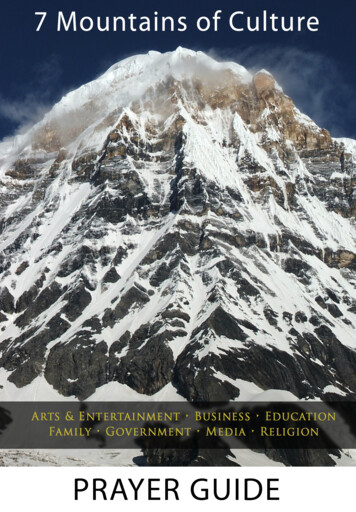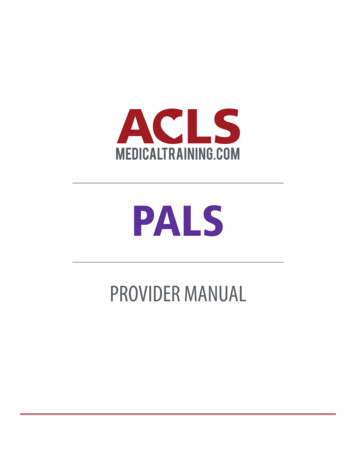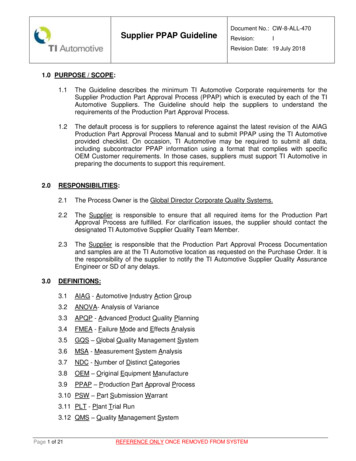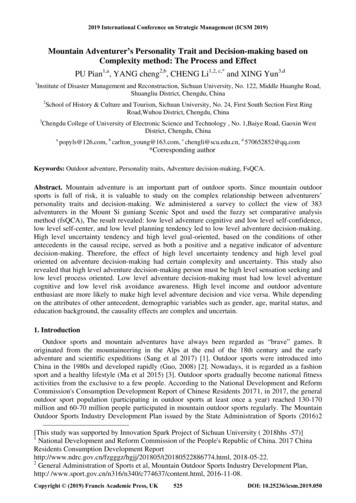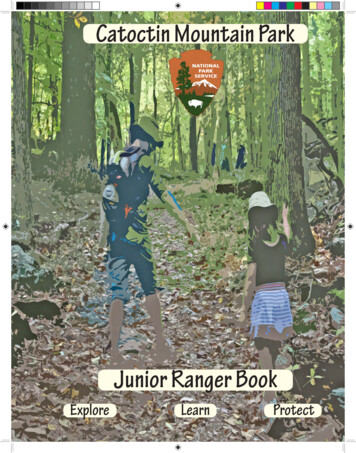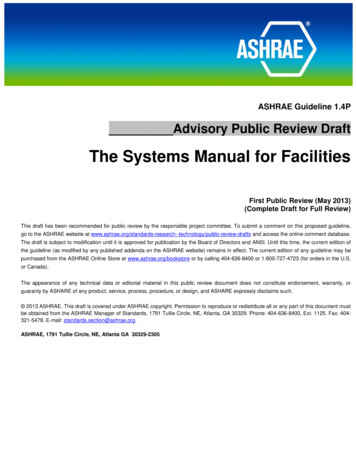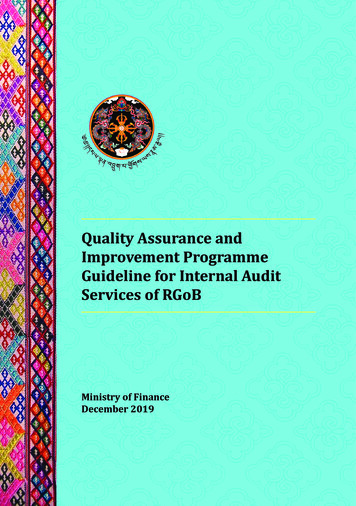
Transcription
MOUNTAIN BIKING DESIGN GUIDELINEThis document provides general guidance in the layout and design of mountain biking trails andfacilities in BSA Council camps. Biking programs offered at high adventure bases, because oftheir scale and customer profile, will vary in terms of scope, challenge and cost and are notaddressed here. This document should be used in conjunction with it’s companion piece,“Mountain Biking Program Guide”OBJECTIVE: The objectives of the BSA Mountain Biking program are three fold:1) To create a safe introduction to the sport. Note: Scoutsshould first be observed in a controlled environment toassure that they are competent to ride the trails. Additionaltraining may be given at this time, if needed.2) To provide a safe and fun environment where a Scout cansharpen the primary skills of the sport.3) To support the mountain biking option of the cycling merit badge.Biking can also be used to promote physical fitness and/or a means of transportationwithin camp.A quality mountain bike (MTB) program should be rooted in education, stewardship, and skillsprogression. The program should provide learning opportunities for all riders, but remainchallenging enough to build confidence and self-esteem at the same time. It is essential thatparticipants are given the necessary resources to push their limits while minimizing the mentaland physical risks. Challenge by choice should be respected and reinforced at every trailfeature.It is recommended that once the Scout has successfully mastered the fundamentals and hasexpressed an interest in highly challenging experiences, the activity be moved off site to afacility operated and maintained by professionals.DEFINITIONS: To clarify what mountain biking is and what it is not, here are a fewdefinitions:Mountain Bike: Mountain Bike is a bicycle created for offroad cycling. Mountain bikes are typically ridden onmountain trails, fire roads, logging roads, and otherunpaved environments.Mountain bike construction differs from a typical bicycle inmany ways. The most noticeable differences are theinclusion of suspension on the fork and possibly theframe, larger knobby tires, more durable heavy dutywheels, more powerful brakes, and lower gear ratiosneeded for steep grades with poor traction.Mountain BikingJanuary 2015DRAFT5
High end mountain bikes are built to handle demanding terrain and the obstacles that arefound in it like logs, vertical drop offs, and smaller boulders.BMX Bike - A BMX bike is an off-road sport bicycle used in a variety of different venues. BMXmeans bicycle motocross. The BMX "Class" bike is a strong, quick- handling, lightweight bikewith a standard 20-inch (510 mm) or 24”(610 mm) -wheel.BMX Racing - is a type of off-road bicycleracing. The format of BMX was derivedfrom motocross racing. BMX bicycleraces are sprint races on purpose-builtoff-road single-lap race tracks. The trackusually consists of a starting gate for up toeight racers, and a groomed, serpentine,dirt race course made up of various jumpsand rollers and a finish line. Typically, thetrack requires constant maintenance whenin use. The course may be sloped or flat,about 15-foot (4.6 m) wide and has largebanked corners to help the riders maintainspeed. Other permutations include pumptracks, freestyle dirt jumping, freestyleurban/skate park riding or flat ground tricks.Challenge by choice: Challenge by choice is a philosophy and strategy within the outdooreducation industry in which participants are invited to challenge themselves and participate ontheir own terms. It’s important to allow participants to choose what participation level they arecomfortable with, set their own goals and measure their own success. It is the instructor’s roleto present the challenge, provide safety instruction for the activity, instruct the participant in theskills required to overcome the challenge, and to guide the participant in setting goals andlevels of success. While an instructor should obviously encourage participants to pushthemselves physically and mentally, participants should never feel forced or coerced out of theircomfort zone.An important aspect of Challenge by choice is that the participant also has to feel that theirchoice will always be accepted by the group as a valid level of participation. This could also beknown as participant buy-in. There are a number of ways to accomplish this, but one major toolin the outdoor education industry is the Full Value Contract. This is a term for a contract that thegroup comes up with together at the beginning of their experience to create a philosophy orculture for their own group dynamics. The instructor should help guide the participants in aproper direction, but it’s important for the group to feel that they have created this contracttogether. This will aid in everyone sticking to the contract and all participants feelingcomfortable within the group culture. In trail design this translates to adding “bail out” or“bypass” elements to challenging obstacles.5
GENERAL GUIDELINES:Bike TrailsMaintaining trails that are safe and environmentally sustainable can be expensive. Safe andsustainable trails are vital to the success of a quality MTB program. Trails should be meticulouslyplanned and mostly sustainable with proper maintenance. Trails must be progressive in nature,starting at the easiest level and working towards more advanced skills.The cost will vary with the degree of difficulty. For example, trails that are very steep are subject toconstant erosion and require care. Good design and trail construction will minimize maintenancecosts and increase safety. Professional help or assistance from recognized biking organizationssuch as the International Mountain Biking Association (IMBA) or the Professional Trail BuildersAssociation (PTBA) can prove invaluable.Highly demanding types of terrain commonly involve challenging use of rocks, washouts, ruts,loose sand, loose gravel, roots, and steep grades (both inclines and declines). W e do notrecommend an advanced level of challenge within a camp environment. However, experiencedbikers may pursue that level of challenge at facilities operated and maintained by professionalsor at our National High Adventure Bases. Because the degree of challenge in a BSA camp isless, the camp will be able to provide simpler equipment that is more affordable.A great trail system will have trails meant for riding up at lower grades and trails meant for ridingdown at steeper grades. Generally, an average trail grade of 10% or less is mostsustainable. Beyond this grade, the trail is easily eroded. This is site specific and fluctuates.Turning radii should be in the 6 to 8 foot range, and the path width should be 36” to 48”. All of thisis dependent on a number of variables such as soil conditions and topography. When we talk aboutthe maximum grade at any particular point, we mean short sections of steep grade followedby mellow grades. Even an intermediate blue trail may have very short, but very steepsections that create little cruxes to power through and provide a sense of accomplishment. Asustainable trail will have b o t h gradient changes and turns to help slough off the water. Forspecific design parameters, IMBA has an excellent resource, “Trail Solutions” published by theIMBA, Boulder, CO. Frequently, maintenance roads, fire lanes and other such routes areincorporated into the trail system.5
The IMBA uses a 5 tier trail difficulty rating system. White (easiest) and green (easy) difficultylevels are entirely appropriate for BSA properties. At the blue square level (difficult), the councilshould consider providing access to professionally managed and maintained trail systems. Blackdiamond (very difficult) and double black diamond (extremely difficult) are not recommended as acouncil operated camp activity due to the potential for injury.Trail Difficulty Rating SystemEasiestWhite CircleEasyGreen CircleMore DifficultBlue SquareVery DifficultBlack DiamondTrail Width72” or more36” or more24” or more12” or moreTreadSurfaceHardened orSurfacedFirm andStableMostly stablewithsome variabilityWidely variableAverageTrail GradeLess than 5%5% or less10% or less15% or lessMaximumTrail GradeMax 10%Max 15%Max 15% orgreaterMax 15% orgreaterNaturalObstaclesand Trailfeatures(TTF)NoneUnavoidableObstacles2” tall or less.UnavoidableObstacles8” tall or less.UnavoidableObstacles15” tall or less.AvoidableObstacles maybe presentAvoidableObstacles maybe presentAvoidableObstacles maybe presentUnavoidablebridges36” or widerUnavoidablebridges24” or widerMay includeloose rocksTFF’s 2’ high orless, width ofdeck is greaterthan ½ theheightUnavoidablebridges24” or widerTFF’s 4’ high orless, width ofdeck is less than ½the heightShort Sectionsmay exceedcriteriaNOTE: IMBA provides for double black diamond riding, however, the BSA does not permit scoutsto use double diamond trails.5
Customized Protocols and Risk Management PlanAll quality mountain bike programs should have well planned and customized policies in place. Thepolicies should address program operation, participant/staff ratios, facility and equipment care, safety,and more. An example document can be found in the Mountain Bike Program Document. All policiesshould be written specifically for the program objectives and capability level of the participants.While considering the financial commitment and policies for your program, it is imperative to beginformulating a detailed Risk Management Plan. The BSA Field Book notes that managing risk requiresplanning, training, leadership, good judgment, and accepting responsibility. Incorporating those specificcharacteristics into a detailed plan will help identify potential hazards, improve overall safety, and limitliability associated with the program. There are many BSA Risk Management resources, but theInternational Mountain Bike Association (IMBA) provides detailed risk management guidance specificallyfor mountain bike programs. We strongly encourage you to utilize their expertise in this field, prior tooperating your own program.Financial Commitment:Operating a mountain bike program is an involved process, but a rewarding way to help engage youth inthe outdoors. Typically one of the first questions would be, “how much does a mountain bike programcost?” Entry level bikes can retail anywhere from 200- 400. The investment related to operating a fleetof 20 entry level mountain bikes (not including infrastructure/facilities/maintenance) can cost 6,000 11,000 for an entry level program fleet. This does not include staffing and operations and maintenancecosts.Alternatives would include renting bikes andequipment from a local bike shop. Onecouncil is known to buy year end “left overs”directly from the manufacturer at significantdiscountInitial Costs 20 units(2015)BikesHelmetsPads/ GlovesTotalLow 3,800 600 1,600 6,000High 8,200 800 2,000 11,000A financially sustainable program wouldinvolve purchasing/selling a specific number of bikes and ancillary equipment per year.Maintenance Considerations:Maintenance will fall into two categories; trail maintenance and equipmentmaintenance.Trail maintenance is important for both environmental sustainability and for safety. Research by theIMBA shows that the most effective way to minimize the environmental effects of trail recreation isthrough good design. Although it is a natural process, trail erosion is the biggest threat to safetyand environmental sustainability. The process is accelerated by the combination of trail users,water and gravity.5
Equipment maintenance will be inevitable but can be mitigated through the selection of simple,sturdy bikes. When deciding on the model of bike to use, camps need to look atmaintenance, expected longevity, ease to ride, and trails that they will be ridden on. One ortwo gears may be necessary to successfully traverse even the easiest terrain. Keep in mindthough, the more complex the machine, the more expensive it will be to acquire and maintain. Asuccessful program will have a “repair shop” and staff or volunteers who are trained inmaintaining bikes.Depending on the caliber of the fleet, maintenance requirements can potentially consume a largeamount of time and money. A rough parts estimate for a 20 bike fleet could range from 1,000 3,000 per year. This doesn’t account for the service time/cost involved with maintaining thefleet, which can be done by a local bike shop or a qualified staff member. Depending on thecaliber of your staff, the fleet should be inspected by a bike shop professional at least once ayear. Based on a 4 year rotation/depreciation of entry level bikes, the total annual costassociated with purchasing bikes, parts, and providing quality service could cost anywhere from 6,000- 9,000 per year.Local bike shops and bike clubs are a good starting place for volunteer assistance in traildesign and equipment and trail maintenance. It is part of the IMBA ethic to seek partnerships, soexplore this aspect thoroughly when contemplating the creation of a bike program.Storage/Maintenance FacilityThe size of your bike fleet should bedetermined by the number of participants youexpect to serve. It is important to have a dry,organized, and efficient place to store, locateand inspect/ repair the bikes.Space in this facility should be designated for aservice/maintenance area that is outfitted withprofessional bike tools . Keeping the propertools organized will look professional, improveefficiency, and improve the staff’s ability toservice the fleet. Having a couple of bike visesis a good idea.If there is not enough inside space for theservice area, consider using a storage area neara roofed outdoor workspace. This will enable your staff to effectively maintain bikes duringinclement weather and focus on program quality/safety when skies are clear. It is helpful when thestorage area enables the staff to distribute bikes directly from the storage area to the participants,as opposed to removing the bikes from storage and staging them for riding in a different location.SignageIf you decide to utilize trails on BSA property, it is imperative that you build proper signage intoyour trail network. Signage is important to limit liability for riders that might “stumble” onto the trailnetwork without proper supervision and to help beginners reduce risk associated with more difficultterrain. For more information on creating effective signage, refer to the IMBA book ManagingMountain Biking in the resources section at the end.5
Land Use Agreements & Strategic PartnershipsAnother option for mountain bike programs is to utilize existing mountain bike trails within your localcommunity. Using an existing trail system has many advantages, but may require additional landmanager permission. Private land use agreements are often less cumbersome than state and federalagreements. If an existing trail system is available for use on public lands, it is imperative to find outwhether or not permits are required for non-profit programming.If building new trails on Council property is not an option and there are no existing trails in the area,consider pursuing strategic partnerships with local land managers like the United States ForestryService, National Park Service, or Bureau of Land Management to create multi-use trails with mountainbiking in mind. Permits are often issued in exchange for conservation work to maintain or build trail.This work helps federal/state agencies achieve their annual goals or “targets.” Proper use and care ofpartnering properties has the potential to grow into something larger than a simple land use agreement.In addition to working with private/public landowners, it is essential to develop working relationshipswith local MTB advocacy groups, trail clubs, and IMBA chapters that can provide guidance for work onBSA properties and offsite trails. These clubs can be great resources for trail building, programdevelopment, or community service opportunities. It is important for participants in a MTB program tounderstand the partnership component, commitment, and hard work that goes into riding greatmountain bike trails.RELATED DOCUMENTS AND WEB SITES: Mountain Biking Program GuideGuide to Safe ScoutingCycling merit badge pamphlet“Trail Solutions” IMBA, Boulder, CO“Managing Mountain Biking” IMBA , Boulder, COo http://www.uci.ch/mountain-bike/about/o gning-and-building-sustainable-trailso 5
Mountain Bike: Mountain Bike is a bicycle created for off-road cycling. Mountain bikes are typically ridden on . Even an intermediate blue trail may have very short, but very steep . The BSA Field Book notes that managing risk requires planning, training, leadership, good judgment, a

